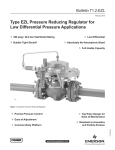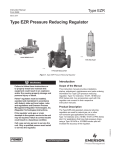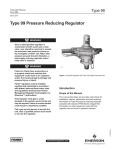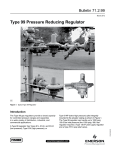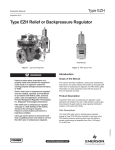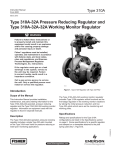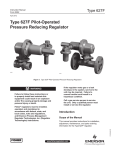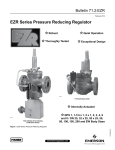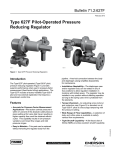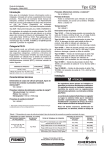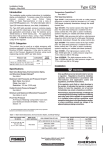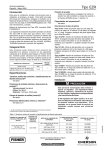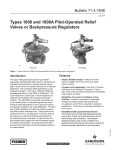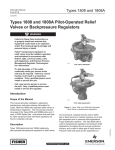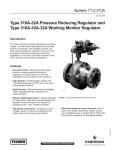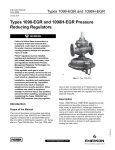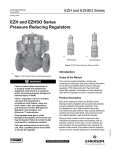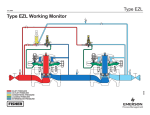Download Emerson EZL Series Pressure Reducing Regulator for Low Pressure Applications Instruction Manual
Transcript
Type EZL Instruction Manual Form 5781 January 2015 Type EZL pressure Reducing Regulator for Low pressure Applications W8962 Figure 1. Type EZL Pressure Reducing Regulator Introduction product Description This manual provides installation, startup, maintenance and parts ordering information for the Type EZL pressure reducing regulator. Information on other equipment used with this regulator is found in separate manuals. Type EZL regulators are accurate pilot-operated, pressure balanced and soft seated regulators. They are designed for use in natural gas distribution applications such as district regulating stations and commercial/industrial meter sets. They provide low differential, smooth, reliable operation, tight shutoff and long life. D103091X012 Scope of Manual www.fisherregulators.com Type EZL Specifications The Specifications section lists the specifications for Type EZL pressure reducing regulator. Factory specifications for specific regulator constructions are stamped on the nameplate fastened to either the main actuator or the pilot spring case. Available Configuration Type EZL: Pilot-operated pressure reducing regulator for low to high outlet pressure Minimum Differential Pressure(1) Body Sizes, End Connection Styles and Pressure Ratings(1) See Table 1 Maximum Pressures(1) Inlet and Outlet (Design): 285 psig / 19.7 bar Emergency (Design Casing): 285 psig / 19.7 bar Operating Differential: 285 psid / 19.7 bar d Outlet Pressure Ranges See Table 2 Minimum Differential for Full Stroke, psid / bar d Trim, Percent of Capacity 100 80 50 30 2 in. / DN 50 3 and 4 in. / DN 80 and 100 2.9 / 0.204 2.9 / 0.204 3.0 / 0.207 3.4 / 0.234 2.9 / 0.204 3.1 / 0214 3.2 / 0.221 3.5 / 0.241 Temperature Capabilities(1) Standard Elastomers: -20 to 180°F / -29 to 82°C High-Temperature Elastomers: 0 to 180°F / -18 to 82°C Options • Prepiped Pilot Supply • Travel Indicator • Integral Type OS2 Slam-shut Device 1. The pressure/temperature limits in this Instruction Manual and any applicable standard or code limitation should not be exceeded. Table 1. Main Valve Body Sizes, End Connection Styles and Body Ratings MAIN VALVE BODY SIZE MAIN VALVE BODY MATERIAL WCC Steel 2, 3 and 4 in. / DN 50, 80 and 100 Cast Iron END CONNECTION STYLES NPT(2) or SWE(2) CL150 RF CL300 RF CL600 RF or BWE NPT(2) CL125B FF CL250B RF STRUCTURAL DESIGN RATING(1) 1500 psig / 103 bar 290 psig / 20.0 bar 750 psig / 51.7 bar 1500 psig / 103 bar 400 psig / 27.6 bar 200 psig / 13.8 bar 500 psig / 34.5 bar 1. Structural Design Rating is the rating for the main valve body. The Type EZL complete assembly is limited to 285 psig / 19.7 bar. 2. Available only on 2 in. / DN 50 body Table 2. Outlet Pressure Ranges pilot type 6352 6353 6354L(1) 6354M(2) 6354H 61L 61HP 161M 161EBM 1. Without diaphragm limiter. 2. With diaphragm limiter. 2 outlet control pressure range psig bar 2 to 10 0.14 to 0.69 3 to 40 0.21 to 2.8 35 to 125 2.4 to 8.6 85 to 200 5.9 to 13.8 175 to 220 12.1 to 15.2 200 to 285 13.8 to 19.7 0.25 to 2 0.02 to 0.14 1 to 5 0.07 to 0.34 2 to 10 0.14 to 0.69 5 to 15 0.34 to 1.0 10 to 20 0.69 to 1.4 15 to 45 1.0 to 3.1 35 to 100 2.4 to 6.9 100 to 285 6.9 to 19.7 5 to 15 0.34 to 1.0 10 to 125 0.69 to 8.6 120 to 300 8.3 to 20.7 5 to 15 0.34 to 1.0 10 to 40 0.69 to 2.8 30 to 75 2.1 to 5.2 4.8 to 9.6 70 to 140 130 to 200 9.0 to 13.8 13.8 to 24.1 200 to 350 Spring Color Spring Part Number Black Yellow Red Blue Blue Green Red Yellow Blue Brown Green Yellow Blue Red Yellow Red Green White Yellow Black Green Blue Red 14A9673X012 1E392527022 1k748527202 1l346127412 1l346127412 15a9258x012 1B886327022 1J857827022 1B886427022 1J857927142 1B886527022 1E392527022 1D387227022 1D465127142 1E392527022 1K748527202 15A9258X012 17B1260X012 17B1262X012 17B1259X012 17B1261X012 17B1263X012 17B1264X012 ype EZL with 6350 Series Pilot and ype P590 Pilot Supply Filter Type EZL “C” Port Loading Pressure “A” Port InLet Pressure “D” Port Sense Pressure TypE 6352 Pilot P590 Series Pilot Supply Filter E0944 Inlet Pressure Outlet Pressure TypE EZL Main Valve LOADING Pressure ATMOSPHERIC Pressure INLET PRESSURE OUTLET PRESSURE Figure 2. Type EZL with Type 6352 Pilot and Type P590 Pilot Supply Filter Operational Schematic ATMOSPHERIC PRESSURE LOADING PRESSURE Principle of Operation the actuator diaphragm escapes downstream through the bleed restriction in the pilot. Single-Pilot Regulator When the gas demand in the downstream system has been satisfied, the outlet pressure increases. The increased pressure is transmitted through the downstream control line and acts on the pilot diaphragm. This pressure exceeds the pilot spring setting and moves the diaphragm, closing the orifice. The loading pressure acting on the main diaphragm bleeds to the downstream system through a bleed restriction in the pilot. The pilot-operated Type EZL (Figure 2 or 3) uses inlet pressure as the operating medium, which is reduced through pilot operation to load the actuator diaphragm. Outlet or downstream pressure opposes loading pressure in the actuator and also opposes the pilot control spring. When outlet pressure drops below the setting of the pilot control spring, pilot control spring force on the pilot diaphragm thus opens the pilot valve plug, providing additional loading pressure to the actuator diaphragm. This diaphragm loading pressure opens the main valve plug, supplying the required flow to the downstream system. Any excess loading pressure on Adjustment The adjustment of the regulator is performed by means of the pilot adjusting screw, which varies the compression of the control spring. Adjustment 3 Type EZL January 2008 Type EZL with Type 61L Pilot Type EZL Sense Pressure Inlet Pressure Loading Pressure P590 Series Pilot Supply Filter E0959 TypE 61L Pilot E0959 TypE EZL Main Valve Inlet Pressure Outlet Pressure LOADING Pressure INLET PRESSURE ATMOSPHERIC Pressure OUTLET PRESSURE LOADING PRESSURE ATMOSPHERIC PRESSURE INLET PRESSURE OUTLET PRESSURE LOADING PRESSURE ATMOSPHERIC PRESSURE Figure 3. Type EZL with Type 61L Pilot and Type P590 Pilot Supply Filter Operational Schematic is performed while the regulator is in operation with the aid of a pressure gauge to monitor downstream pressure. The shutoff valve downstream of the regulator must not be completely closed; it is necessary that a small quantity of gas flows downstream to allow the outlet side to vent, when it is necessary to lower the pressure. Monitoring Systems Monitoring regulation is overpressure protection by containment, therefore, there is no relief valve to vent to the atmosphere. When the working regulator fails to control the pressure, a monitor regulator installed in series, which has been sensing the downstream and control pressure, goes into operation to maintain the downstream pressure at a slightly higher than normal pressure. During an overpressure situation, monitoring keeps the customer on line. Also, testing is relatively easy and safe. To perform a periodic test on a monitoring regulator, increase the outlet set pressure of the working regulator and watch the outlet pressure to determine if the monitoring regulator takes over at the appropriate outlet pressure. 4 Wide-Open Monitoring Systems (Figure 4) There are two types of wide-open monitoring systems: upstream and downstream. The difference between upstream and downstream monitoring is that the functions of the regulators are reversed. Systems can be changed from upstream to downstream monitoring and vice-versa, by simply reversing the setpoints of the two regulators. The decision to use either an upstream or downstream monitoring system is largely a matter of personal preference or company policy. In normal operation of a wide-open configuration, the working regulator controls the system’s outlet pressure. With a higher outlet pressure setting, the monitor regulator senses a pressure lower than its setpoint and tries to increase outlet pressure by going wide-open. If the working regulator fails, the monitoring regulator assumes control and holds the outlet pressure at its outlet pressure setting. TypeEZL EZL Type Type EZL Upstream or Downstream Wide-Open Monitor January 2008 Type 67C Pilot Supply Regulator P590 Series Pilot Supply Filter TypE 6352 Pilot P590 Series Pilot Supply Filter E0948 TypE 6352 Pilot E0948 INLET PRESSURE OUTLET InletPRESSURE Pressure LOADING PRESSURE Outlet Pressure INTERMEDIATE PRESSURE LOADING Pressure ATMOSPHERIC PRESSURE INTERMEDIATE Pressure TypE EZL Main Valve INLET PRESSURE OUTLET PRESSURE LOADING PRESSURE INTERMEDIATE PRESSURE ATMOSPHERIC PRESSURE TypE EZL Main Valve Atmospheric Pressure Figure 4. Wide-Open Monitoring System Operational Schematic Working Monitoring Regulators (Figure 5) In a working monitoring system, the upstream regulator requires two pilots and it is always the monitoring regulator. The additional pilot permits the monitoring regulator to act as a series regulator to control an intermediate pressure during normal operation. In this way, both units are always operating and can be easily checked for proper operation. In normal operation, the working regulator controls the outlet pressure of the system. The monitoring regulator’s working pilot controls the intermediate pressure and the monitoring pilot senses the system’s outlet pressure. If the working regulator fails, the monitoring pilot will sense the increase in outlet pressure and take control. Note The working regulator must be rated for the maximum allowable operating pressure of the system because this will be its inlet pressure if the monitoring regulator fails. Also, the outlet pressure rating of the monitoring pilot and any other components that are exposed to the intermediate pressure must be rated for full inlet pressure. Working monitor installations require a Type EZL main valve with a working pilot and a monitoring pilot for the upstream regulator and a Type EZL with the appropriate pilot for the downstream regulator. Adjustment Adjusting the monitor regulator is similar to adjusting the main regulator. Monitor setpoints are set slightly higher than the main regulator. However, the value of this difference cannot be determined in advance, as it depends on the particular characteristics of each application. 5 Type EZL Type EZL January 2008 Type EZL Working Monitor P590 Series Pilot Supply Filter TypE 161EBM Monitor Pilot TypE 6352 Pilot TypE 6352 Pilot E0946 P590 Series Pilot Supply Filter INLET PRESSURE TypE EZL Main Valve OUTLET PRESSURE Inlet Pressure LOADING PRESSURE Outlet Pressure INTERMEDIATE PRESSURE ATMOSPHERIC PRESSURE LOADING Pressure E0946 TypE EZL Main Valve INTERMEDIATE Pressure Atmospheric Pressure Figure 5. Working Monitoring System Operational Schematic Installation ! Warning Personal injury or equipment damage, due to bursting of pressure-containing parts may result if this regulator is overpressured or is installed where service conditions could exceed the limits given in the Specification section and on the appropriate nameplate or where conditions exceed any rating of the adjacent piping or piping connections. To avoid such injury or damage, provide pressure-relieving or pressure-limiting devices to prevent service conditions from exceeding those limits. Also, be sure the installation is in compliance with all applicable codes and regulations. Additionally, physical damage to the regulator could break the pilot off the main valve, causing personal injury and 6 property damage due to bursting of pressure-containing parts. To avoid such injury and damage, install the regulator in a safe location. All Installations A Type EZL regulator bleeds no gas to atmosphere during normal operation, thus making the regulator suitable for installation in pits and other enclosed locations without elaborate venting systems. This regulator also can be installed in pits subject to flooding by venting the pilot spring case above the expected flood level so that the pilot setting can be referenced to atmospheric pressure. 1. Only personnel qualified through training and experience should install, operate and maintain a regulator. Before installation, make sure that there is no damage to or debris in the regulator. Also, make sure that all tubing and piping are clean and unobstructed. Type EZL Note When upgrading Fisher® control valves, such as Types ET, ED and ES make sure the body is in the flow up direction. 2. Install the regulator so that the flow arrow on the main valve matches the flow direction of process fluid through the regulator. 3. Apply pipe comlb to the external pipeline threads before installing a regulator with threaded end connections. Use gaskets between pipeline and regulator flanges when installing a regulator with flanged end connections. When installing buttweld end connections, remove trim before welding and make sure to use approved welding practices. Use approved piping procedures when installing the regulator. ! Warning A regulator may vent some gas to the atmosphere. In hazardous or flammable gas service, vented gas may accumulate, causing personal injury, death or property damage due to bursting of pressure-retaining parts. Vent a regulator in hazardous gas service to a remote, safe location away from air intakes or any hazardous location. The vent line or stack opening must be protected against condensation or clogging. 4. Pilots have a 1/4 in. NPT vent connection in the spring case. To remotely vent gas from the spring case, remove the screened vent and connect 1/4 in. / 6.4 mm piping or tubing to the spring case connection. The piping or tubing should vent to a safe location, have as few elbows as possible and have a screened vent on its exhaust. Install the regulator and any remote vent piping or tubing so that the vent is protected from condensation, freezing or substances that may clog it. caution To avoid freezeup because of pressure drop and moisture in the gas, use antifreeze practices, such as heating the supply gas or adding a de-icing agent to the supply gas. 5. Run a 3/8 in. / 9.5 mm outer diameter or larger pilot supply line from the upstream pipeline to the filter inlet as shown in Figure 3, bushing the line down to fit the 1/4 in. threaded NPT filter connection. Do not make the upstream pipeline connection in a turbulent area, such as near a nipple, swage or elbow. If the maximum pilot inlet pressure could exceed the pilot rating, install a separate reducing regulator in the pilot supply line. Install a hand valve in the pilot supply line and provide vent valves to properly isolate and relieve the pressure from the regulator. 6. Attach a 1/2 in. / 12 mm piping or tubing downstream control line to the 1/2 in. threaded NPT control line connection on the actuator casings. Connect the other end of the control line to the pipeline downstream of the regulator. Do not attach the control line near any elbow, swage, block valve or any other location that might cause turbulence. Install a full port ball valve in the control line to shutoff the control pressure when using the bypass. 7. If a quick acting solenoid is to be installed downstream of a regulator, the regulator and solenoid should be located as far apart as practical. This will maximize the gas piping volume between the regulator and solenoid and improve the regulator response to quick changing flow rates. 8. Consult the appropriate instruction manual for installation of an optional pneumatic or electric remote control drive unit. For optional remote pneumatic loading of a 6350 or 61 Series pilot, make the loading piping connections to the 1/4 in. NPT vent connection. Wide-Open Monitor Regulator (Figure 4) 1. Follow the procedures in the All Installations section and then continue with step 2 of this section. 2. Connect the control line of the wide-open monitoring regulator to the downstream piping near the working regulator control line connection. During normal operation, the wide-open regulator stands wide-open with the pressure reduction being taken across the working regulator. Only in case of working regulator failure does the wide-open monitoring regulator take control at its slightly higher setting. Regardless of which regulator is used as the monitor, it should be equipped with a pilot supply regulator set to limit the pilot supply pressure to 10 to 15 psig / 0.69 to 1.0 bar above control pressure. Since the 7 Type EZL pilot on the monitoring regulator is wide-open during normal operation, the pilot supply regulator is used to prevent differential pressure relief valve chatter on the monitoring regulator pilot. Working Monitor Regulator (Figure 5) Startup 1. Follow the procedure in the All Installations section and then continue with step 2 of this section. 1. Make sure all block valves, vent valves and control line valve(s) are closed. 2. Attach 3/8 in. / 9.5 mm tubing (for Types 161M and 161EBM) downstream control line to the control line (sense) connection on the pilot. Connect the other end of the control line to the pipeline downstream of the downstream working regulator. Do not attach the control line near any elbow, swage, block valve or any other location that might cause turbulence. 2. Back out the pilot adjusting screw(s). 3. Apply pilot sense pressure by connecting the outlet of the monitor pilot to the inlet of the working monitor pilot. 5. For a single regulator, set the pilot to the desired outlet (control) pressure according to the Pilot Adjustment procedure. For a wide-open downstream monitor installation, adjust the upstream working pilot until intermediate pressure is higher than the desired setpoint of the monitor pilot. Adjust the downstream monitoring pilot to the desired monitoring takeover pressure. Reduce the upstream pilot to the normal outlet pressure setting. For a wide-open upstream monitor installation, adjust the downstream working pilot to a setpoint higher than the setpoint of the monitor pilot. Adjust the downstream monitoring pilot to the desired monitoring takeover pressure. Reduce the upstream pilot to the normal outlet pressure setting. For a working monitor installation, adjust the setpoint of the upstream monitor pilot to the desired maximum pressure. Adjust the upstream working pilot to the desired intermediate pressure setting. Adjust the downstream pilot to a pressure setting slightly above the upstream monitor pilot pressure setting. Adjust the upstream monitor pilot to its desired setpoint. Establish final desired downstream pressure by adjusting the downstream working regulator pilot. Startup and Adjustment Pre-startup Considerations Each regulator is factory-set for the outlet pressure specified on the order. If no setting was specified, outlet pressure was factory-set at the mid-range of the pilot control spring. Before beginning the startup procedure in this section, make sure the following conditions are in effect: • Block valves isolate the regulator • Vent valves are closed • A bypass, if any, is in operation In all cases, check the control spring setting to make sure it is correct for the application. caution Be sure to slowly introduce pressure into the system to prevent downstream overpressure due to potential rapid pressure increase. Pressure gauges should always be used to monitor downstream pressure during startup. Procedures used in putting this 8 regulator into operation must be planned accordingly if the downstream system is pressurized by another regulator or by a manual bypass. 3. Slowly open the valves in the following order: a. Pilot supply and control line valve(s), if used. b. Inlet block valves. 4. Crack open the outlet block valve or bypass valve to allow minimum flow. 6. After adjusting the pilot(s) to the desired pressure setting(s), slowly open the downstream block valve wide-open. 7. Close the bypass valve, if used. Type EZL Pilot Adjustment caution Remove closing cap, if necessary. Loosen the locknut. Turn the adjusting screw into the spring case to increase the downstream pressure. Turn the adjusting screw out of the spring case to decrease the downstream pressure. Use a pressure gauge to monitor the outlet pressure until the desired pressure is reached. When the required downstream pressure is maintained for several minutes, tighten the locknut to lock the adjusting screw in position. Replace the pilot closing cap, if necessary. Shutdown caution If the pilot bleed control line pressure is shutdown first, the downstream system may be subjected to full inlet pressure. 1. If the pilot setting must be disturbed, be sure to keep some tension on the spring. This will prevent trapping inlet pressure during blow down. 2. Slowly close the valves in the following order: a. Inlet block valve b. Outlet block valve c. Control line valve(s), if used. 3. Open the vent valves to depressurize the system. Maintenance The regulator parts are subject to normal wear and must be inspected periodically and replaced as necessary. The frequency of inspection and replacement depends on the severity of service conditions and on applicable federal, state and local codes and regulations. ! Warning To avoid personal injury or property damage from sudden release of pressure, isolate the regulator from the pressure system and release all pressure from the pilot and main valve before performing maintenance operations. When disassembling the upper and lower actuator, always remove the long cap screws (key 39) last to allow spring tension force to be released in a slow and controlled manner. Use proper lifting techniques, when lifting the upper and lower actuator casings (keys 11 and 5) off the Type EZL body (key 1). The 2 in. / DN 50 actuator assembly weighs more than 40 lbs / 18 kg. Type EZL (Figure 7) Seat Maintenance 1. Make a mark on the lower actuator casing (key 5), intermediate flange (key 25) and body (key 1) to indicate proper alignment. 2. Remove stud nuts (key 26). caution Use proper care in moving actuator to ensure no damage occurs to the pins or actuator casings. 3. Carefully lift the actuator assembly (keys 11 and 5) off the body (key 1). 4. Remove O-ring (key 34) from lower actuator casing (key 5). Inspect the O-ring for damage or wear and replace if necessary. Lightly lubricate O-ring before placing on lower actuator casing (key 5). 5. Remove the hex socket cap screws (key 33) and spring lock washers (key 32). Lift off the disk holder assembly (key 30) and disk retainer (key 31). 6. Remove the O-ring (key 29). Inspect for damage or wear and replace if necessary. Lightly lubricate O-ring before placing in the sleeve adaptor (key 27). 7a. On the 2 and 3 in. / DN 50 and 80 sizes remove the seat ring (key 2), spring washer (key 72) and O-ring (key 34) (see Figure 7, Detail A.2). Inspect the O-ring for damage or wear, replace if necessary. 9 Type EZL Table 3. Torque Specifications Torque Specifications, ft-lbs / N•m Body Size Indicator Fitting (key 56) or Plug (key 38) Stud Nuts (key 26) Socket Head Cap Screws (key 16)(1)(2) Cap Screws (keys 21 and 39) Cap Screws (key 6) Socket Head Cap Screws (key 33)(1) 2 in. / DN 50 10 to 15 / 15 to 20 45 to 50 / 60 to 70 55 to 60 / 75 to 80 35 to 45 / 50 to 60 50 to 60 / 70 to 80 55 to 60 / 75 to 80 3 and 4 in. / DN 80 and 100 10 to 15 / 15 to 20 80 to 95 / 110 to 130 90 to 100 / 120 to 135 31 to 34 / 42 to 46 70 to 95 / 95 to 130 80 to 90 / 110 to 120 1. Socket head cap screw (keys 16 and 33) torque specifications are given in in-lbs. 2. Apply torque to each screw in star pattern, 5 complete rounds. 7b. On the 4 in. / DN 100 size remove the intermediate flange (key 25), seat ring (key 2) and O-ring (key 75) (see Figure 7, Detail A.2). The seat ring (key 2) can be moved out of the way and the O-ring (key 75) can be removed without removing the intermediate flange (key 25). Inspect the O-ring for damage or wear, replace if necessary. Note If also inspecting the intermediate flange O-ring, go to step 4 in the Intermediate Flange O-ring Maintenance section below. 8a. For the 2 and 3 in. / DN 50 and 80 sizes reinstall the spring washer (key 72) with the inside edge pointing up. Lightly lubricate O-ring (key 34) before placing on top of the spring washer (key 72) in the body (key 1). 8b. For the 4 in. / DN 100 size lightly lubricate the O-ring (key 75) and place it in the body (key 1). 9. Set the seat ring (key 2) back in the body (key 1) with the curved side down and the seat edge up. 10. Place the disk holder assembly (key 30) and disk retainer (key 31) on the sleeve adaptor (key 27). 11. Insert the spring lock washers (key 32) and hex socket cap screws (key 33) and tighten. See Torque Specification table for proper torque. 12. Lubricate surface between lower casing and intermediate flange. Carefully lift the upper actuator casing and lower actuator casing assembly (keys 11 and 5) and place on the body (key 1). Secure with stud nuts (key 26). See Torque Specification table for proper torque. 10 Intermediate Flange O-ring Maintenance 1. Make a mark on the lower actuator casing (key 5), intermediate flange (key 25) and body (key 1) to indicate proper alignment. 2. Remove stud nuts (key 26). 3. Carefully lift the upper actuator casing and lower actuator casing assembly (keys 11 and 5) off the body (key 1). 4. Remove cap screws (key 6). 5. Lift off intermediate flange (key 25). 6. Remove O-ring (key 7). Inspect the O-ring for damage or wear and replace if necessary. Lightly lubricate O-ring before placing in the body (key 1). Note If performing Seat Maintenance in conjunction with Intermediate Flange O-ring, return to step 7 of the Intermediate Flange O-ring Maintenance section. 7. Replace the intermediate flange (key 25), make sure to position the stud bolt (key 24) holes on the outsides of the body (key 1). Secure with cap screws (key 6). See Torque Specification table for proper torque. 8. Lubricate the surface between the lower casing and the intermediate flange. Reinstall actuator assembly to body. Type EZL Actuator Assembly Maintenance 1. Make a mark on the upper actuator casing (key 11), lower actuator casing (key 5), intermediate flange (key 25) and body (key 1) to indicate proper alignment. 2. Remove travel indicator assembly, if present, by loosening the travel indicator fitting (key 56) and lifting out the indicator assembly. Refer to Travel Indicator Maintenance section for maintenance procedure. 3. Remove cap screws (key 21), washers (key 22) and hex nuts (key 23). Remove all the short cap screws first, then evenly remove the two long cap screws (key 39) and brackets (key 35). Take care to balance the upper actuator casing while removing the spring tension. Carefully lift the upper actuator casing (key 11) off the lower actuator casing (key 5). Remove spring (key 13). 4. Remove the hex socket cap screws (key 16). Lift off the diaphragm (key 20) and the inlet plate (key 18). Remove O-rings (keys 15 and 17). Inspect the diaphragm and O-rings for damage or wear and replace if necessary. 5. Inspect the upper actuator casing (key 11), O-ring (key 9), anti-friction split rings (key 8) and anti-friction ring (key 4) for damage or wear. If damaged, remove the O-ring and split rings and replace with new parts. Lightly lubricate the O-ring and split rings. Place the split rings in the body first, then slide the O-ring between the split rings. 6. Remove hex nuts (key 26) from the stud bolts (key 24). Lift off the lower actuator casing (key 5). Remove the hex socket cap screws (key 33) and spring lock washers (key 32). Lift off the disk holder assembly (key 30) and disk retainer (key 31). 7. Slide the sleeve (key 14) out of the lower actuator casing (key 5) and slide the outlet plate (key 19) off of the sleeve. Check the sleeve for scratches, burrs or other damage and replace if necessary. damaged, remove the O-ring and split rings and replace with new parts. Lightly lubricate the O-ring and split rings. Place the split rings in the body first, then slide the O-ring between the split rings. 9. Slide the outlet plate (key 19) onto the sleeve (key 14) and slide the sleeve into the lower actuator casing (key 5). Place the disk holder (key 30) and disk retainer (key 31) on the sleeve adaptor (key 27). Insert the spring lock washers (key 32) and hex socket cap screws (key 33) and tighten. See Torque Specification table for proper torque. If seat was removed, make sure to reinstall. 10. Lightly lubricate the O-rings (keys 15 and 17) and the inner and outer diaphragm (key 20) edges. Make sure O-rings (keys 15 and 17) are correctly positioned. Place the inlet plate (key 18) and the diaphragm (key 20) on the sleeve (key 14). Insert and tighten the hex socket cap screws (key 16). See Torque Specification table for proper torque. 11. Lubricate surface between lower casing and intermediate flange. Carefully lift the lower actuator casing assembly (key 5) and place on the body (key 1). Take care to match up the alignment marks. Secure with stud bolts and nuts (keys 24 and 26). See Torque Specification table for proper torque. 12. Lightly lubricate the spring (key 13) and place on the inlet plate (key 18). 13. Carefully place the upper actuator casing (key 11) on the lower actuator casing (key 5). Take care to match up the alignment marks. Insert the two long cap screws (key 39) and brackets (key 35) 180° apart and away from flanges. Place the washers (key 22) and hex nuts (key 23) on the long cap screws and evenly tighten. Using proper bolting techniques, install remaining small cap screws (key 21), washers and hex nuts. See Torque Specification table for proper torque. 14. Place travel indicator assembly in the upper actuator casing (key 11), if present and tighten the travel indicator fitting (key 56). 8. Inspect the lower actuator casing (key 5), O-ring (key 9), anti-friction split rings (key 8) and anti-friction ring (key 4) for damage or wear. If 11 Type EZL 55 TOP VIEW 55 53 53 TOP VIEW 54 54 55 55 L1 12A P1765 56 L1 12B 56 76 70 L1 70 L1 57 S1 57 S1 LEGACY TRAVEL INDICATOR DETAIL IMPROVED TRAVEL INDICATOR DETAIL APPLy LuBRICANT (L) or Sealant (S) l1 = LITHIUM HYDROXYSTEGRATE NLGI 2 GRADE GREASE S1 = ANAEROBIC METHACRYLATE SEALANT FOR NUTS AND BOLTS (1) 1. Lubricant and sealant must be selected such that they meet the temperature requirements. Figure 6. Travel Indicator Assembly Drawings Type EZL Travel Indicator Maintenance A new and improved version of the travel indicator has been phased in during 2013. The new version improves the O-ring seal to minimize leakage and extend service life. The components of the legacy and new versions are not interchangeable. If maintenance is performed on the travel indicator, it is recommended to replace the entire travel indicator assembly with the new version. Part numbers for the assemblies are shown in the parts list. Figure 6 shows the difference between the designs. The spare parts kits will support either design. Take care to use the correct O-ring (key 12A or 12B) when performing maintenance, see parts list for the appropriate part number. 1. Remove plastic travel indicator cover (key 53). 2. Loosen travel indicator bushing (key 55) and remove it by sliding it over the travel indicator stem (key 54). 3. Remove indicator fitting (key 56) and inspect O-ring (key 70). Remove O-ring (key 12B) and backup rings (key 76). Replace and lubricate O-ring if damaged. Pull up on the travel indicator stem (key 54) to force the spring collet (key 57) out of the diaphragm head groove. Examine these parts and the stem for wear and replace if necessary. 12 4. Insert the travel indicator stem (key 54) and spring collet (key 57) back into the diaphragm head groove. Replace the indicator fitting (key 56) and O-ring (key 70) and tighten with a referenced torque of 3.7 ft-lbs / 5 N•m. 5. Lubricate the O-ring (key 12B) and backup rings (key 76, 2 required). Place one back-up ring on the stem (key 54) followed by the O-ring and then the other back-up ring. Push into groove of the indicator fitting (key 56). 6. Slide the travel indicator bushing (key 55) over the travel indicator stem (key 54) and tighten firmly in place. 7. Replace the travel indicator cover (key 53) and tighten firmly in place. Pilot Maintenance Types 6352 through 6354M Pilots Perform this procedure if changing the control spring for one of a different range or if inspecting, cleaning or replacing any other pilot parts. Pilot part key numbers are referenced in Figure 8. Type EZL Note The body (key 1) may remain on the pipe nipple (key 21, Figure 8 or key 24, Figure 9) unless the entire pilot is replaced. 1. To gain access to the diaphragm assembly (key 5), diaphragm limiter (key 23) if used, control spring (key 6), restriction (key 22), stem guide (key 8) or spring seat (key 7), remove the closing cap (key 11), loosen the locknut (key 10) and turn the adjusting screw (key 9) counter clockwise until compression is removed from the spring. Remove the machine screws (key 14) and separate the body from the spring case (key 2). 2. Inspect the removed parts and replace as necessary. Make sure the restriction and the registration hole in the body are free from debris. After assembly, make sure of the proper control spring setting according to the Startup section and re-mark the spring case if necessary. 3. To replace the valve plug (key 4) or bellows O-ring (key 17), remove the body plug (key 3) and body plug gasket (key 12). Be careful to keep the bellows assembly (key 16) from falling out and possibly getting lost while removing the valve plug. Inspect the removed parts and replace as necessary. Make sure the valve plug seating surfaces are free from debris. 61 Series Pilot Perform this procedure if changing the control spring for one of a different range or if inspecting, cleaning or replacing relief valve or any other pilot parts. Pilot part key numbers are referenced in Figure 9. 1. Remove the pilot from the pipe nipple (key 24) unless just the control spring is to be changed. 2. To gain access to the control spring or other internal parts, remove the closing cap assembly (key 5) and relieve control spring (key 7) compression by turning the adjusting screw (key 6) counter clockwise. Change the control spring and install the adjusting screw and closing cap assembly if no other maintenance will be performed. Make sure of the proper control spring setting according to the Installation and Startup section and restamp the nameplate if necessary. remove the cap screws (key 20) and separate the pilot into three sections; spring case (key 1), body (key 2) and bottom cover (key 3). 4. To inspect the two diaphragms (keys 14 and 15) thoroughly, remove the diaphragm nut (key 11), hex nut (key 19) and the upper and lower relay heads (keys 16 and 17). The projecting prong in the body may be used as the restraining member to keep the yoke from turning while removing the nuts. Also inspect the O-ring (key 12) and replace any parts as necessary. 5. Take the yoke (key 4) and attached parts out of the body to examine the disk holder assembly (key 9). Remove the relay orifice (key 8) to check for clogging and replace if necessary. 6. To replace the disk holder assembly, first unscrew the bleed orifice (key 10). Remove it and the associated parts. Then unscrew the disk holder assembly from the bleed valve (key 26) to gain access to the relay spring (key 13). Clean or replace any parts as necessary before reassembling. 7. Upon reassembly, pay particular attention to the following assembly suggestions. a. Before replacing the diaphragm case or spring case, be sure the yoke assembly is positioned so that it will not bind or rub on the prong in the relay body. b. Avoid wrinkling the diaphragms when replacing the diaphragm case and spring case. c. Replace the diaphragm case, carefully working the upper relay diaphragm (key 14) into the recess in the diaphragm case. If the diaphragm case rocks with respect to the pilot body, diaphragm is probably wrinkled. d. Replace the spring case, using care to smooth the lower relay diaphragm (key 15) evenly into the recess in the pilot body. e. Install the eight cap screws, tightening them down evenly in a crisscross pattern to avoid crushing the diaphragm. Recommended final torque on these cap screws is 10 to 12 ft-lbs / 14 to 16 N•m. 8. After assembly, make sure of the proper control spring setting according to the Installation and Startup section and restamp the nameplate (key 27) if needed. 3. For any other internal maintenance, relieve control spring compression according to step 2. Then 13 Type EZL Types 161M and 161EBM Pilots Key numbers are referenced in Figure 10 unless otherwise noted. Trim Parts 1. As shown in Figure 10, remove the body plug (key 3). Use needle nose pliers to remove the plug spring (key 6) and plug/stem assembly (key 4). 2. Inspect the removed parts and body plug O-ring (key 15), replace as necessary and make sure the plug seating surfaces are free from debris. 3. Sparingly apply lubricant to the body plug O-ring (key 15) and the threads of the body plug (key 3). Install the body plug O-ring over the body plug. 4. As shown in Figure 10, stack the plug spring (key 6) and plug/stem assembly (key 4) on the body plug (key 3). Install the body plug with stacked parts into the body (key 1). Diaphragm Parts 1. Remove the closing cap (key 16), loosen the locknut (key 12) and back out the adjusting screw (key 11) until compression is removed from the control spring (key 9). 2. Remove the machine screws (key 13) and separate the spring case (key 2) from the body assembly (key 1). Remove the control spring seat (key 8), the control spring (key 9) and, if used, the diaphragm limiter (key 10). 3. Remove the diaphragm assembly (key 7) and inspect the diaphragm. 4. To gain access to the stem guide seal O-ring, remove and inspect the stem guide seal assembly (key 19) and if damaged replace the complete assembly. Inspect the outer O-ring (key 22), replace if necessary. 5. Install the diaphragm assembly (key 7) and push down on it to see if the plug/stem assembly (key 4) strokes smoothly and approximately 1/16 in. / 1.6 mm. Note In step 6, if installing a control spring with a different range, be sure to replace the spring range indicated on the spring case with the new spring range. A diaphragm limiter (key 10) and other listed parts are required with the highest spring range. 14 6. As shown in Figure 10, stack the control spring (key 9), the control spring seat (key 8) and, if used, the diaphragm limiter (key 10) onto the diaphragm assembly (key 7). Make sure that, if used, the diaphragm limiter is installed bevelled side up. Sparingly apply lubricant to the control spring seat. 7. Install the spring case (key 2) on the body (key 1) with the vent (key 18) oriented to allow for wrenches, needed for connecting outlet piping and to prevent clogging or entrance of moisture. Install the machine screws (key 13) and, using a crisscross pattern, torque them to 5 to 7 ft-lbs / 6.8 to 9.5 N•m for Stainless steel constructions and 2 to 3 ft-lbs / 2.7 to 4.1 N•m for aluminum constructions. Note Spring case vent may be mounted in any orientation convenient to your application, but plastic vent (key 18) should be oriented downward. 8. When all maintenance is complete, refer to the Startup and Adjustment section to put the regulator back into operation and adjust the pressure setting. Tighten the locknut (key 12), replace the closing cap gasket (key 17) if necessary and install the closing cap (key 16). Parts Ordering Each Type EZL regulator is assigned a serial number, which can be found on the nameplate. Refer to the number when contacting your local Sales Office for technical information or ordering parts. Also be sure to include the complete 11-character part number from the following Parts List. Parts List Type EZL Main Valve (Figure 7) Key DescriptionPart Number Seat Parts Kits 2 and 3 in. / DN 50 and 80 (includes key numbers: 29, 30 and 34) 4 in. / DN 100 (includes key numbers: 29, 30, 34 and 75) 2 in. / DN 50, Nitrile (NBR) and Fluorocarbon (FKM) REZL2X00N12 2 in. / DN 50, Fluorocarbon (FKM) REZL2X00F12 3 in. / DN 80, Nitrile (NBR) and Fluorocarbon (FKM) REZL3X00N12 3 in. / DN 80, Fluorocarbon (FKM) REZL3X00F12 4 in. / DN 100, Nitrile (NBR) and Fluorocarbon (FKM) REZL4X00N12 4 in. / DN 100, Fluorocarbon (FKM) REZL4X00F12 Type EZL Type EZL Main Valve (Figure 7) (continued) Key DescriptionPart Number Key DescriptionPart Number Seat and Diaphragm Parts Kits 2 and 3 in. / DN 50 and 80 (includes key numbers: 4, 7, 8, 9, 12B, 15, 17, 20, 28, 29, 30, 34, 70 and 76) 4 in. / DN 100 (includes key numbers: 4, 7, 8, 9, 12B, 15, 17, 20, 28, 29, 30, 34, 70, 75 and 76) 2 in. / DN 50, Nitrile (NBR) and Fluorocarbon (FKM) 2 in. / DN 50, Fluorocarbon (FKM) 3 in. / DN 80, Nitrile (NBR) and Fluorocarbon (FKM) 3 in. / DN 80, Fluorocarbon (FKM) 4 in. / DN 100, Nitrile (NBR) and Fluorocarbon (FKM) 4 in. / DN 100, Fluorocarbon (FKM) REZL2X00N22 REZL2X00F22 REZL3X00N22 REZL3X00F22 Travel Indicator Parts Kits 2 in. / DN 50 (includes key numbers: 12B, 53, 54, 55, 56, 57, 58, 70 and 76) 3 and 4 in. / DN 80 and 100 (includes key numbers: 12B, 53, 54, 55, 56, 57, 58, 70 and 76) 1 Body 2 in. / DN 50 Cast Iron NPT CL125 FF CL250 RF Steel NPT CL150 RF Standard Tapped inlet and outlet CL300 RF Standard Tapped inlet and outlet CL600 RF Standard Tapped inlet and outlet BWE, Schedule 40 BWE, Schedule 80 SWE 3 in. / DN 80 Cast Iron CL125 FF CL250 RF Steel CL150 RF Standard Tapped inlet and outlet CL300 RF Standard Tapped inlet and outlet CL600 RF Standard Tapped inlet and outlet BWE, Schedule 40 BWE, Schedule 80 4 in. / DN 100 Cast Iron CL125 FF CL250 RF Steel CL150 RF Standard Tapped inlet and outlet *Recommended spare part REZL4X00N22 REZL4X00F22 ERSA01550A0 ERSA01555A0 GE10583X012 GE10585X012 GE10587X012 GE10588X012 GE10676X032 14B5834X032 GE10676X012 14B5834X042 GE10679X012 14B5834X052 GE10680X012 GE10681X012 GE10682X012 GE10689X012 GE10698X012 GE10699X012 14B5835X032 GE10700X012 14B5835X042 GE10701X012 14B5835X052 GE10702X012 GE10703X012 GE10707X012 GE10822X012 GE10835X012 14B5836X032 1 Body (continued) 4 in. / DN 100 (continued) Steel (continued) CL300 RF Standard Tapped inlet and outlet CL600 RF Standard Tapped inlet and outlet BWE, Schedule 40 BWE, Schedule 80 2 Seat Ring 2 in. / DN 50 3 in. / DN 80 4 in. / DN 100 3* Pin 2 in. / DN 50 (6 required) 3 and 4 in. / DN 80 and 100 (8 required) 4* Anti-Friction Ring (2 required) 2 in. / DN 50 3 and 4 in. / DN 80 and 100 5 Actuator Lower Casing 2 in. / DN 50 3 and 4 in. / DN 80 and 100 6 Cap Screws (8 required) 2 in. / DN 50 3 and 4 in. / DN 80 and 100 7* O-ring 2 in. / DN 50 Nitrile (NBR) Fluorocarbon (FKM) 3 in. / DN 80 Nitrile (NBR) Fluorocarbon (FKM) 4 in. / DN 100 Nitrile (NBR) Fluorocarbon (FKM) 8* Anti-Friction Rings (4 required) 2 in. / DN 50 3 and 4 in. / DN 80 and 100 9* O-ring (2 required) 2 in. / DN 50 Nitrile (NBR), -20 to 180°F / -29 to 82°C Fluorocarbon (FKM) 3 and 4 in. / DN 80 and 100 Nitrile (NBR), -20 to 180°F / -29 to 82°C Fluorocarbon (FKM) 10 Pipe Plug (up to 3 required), All sizes 11 Actuator Upper Casing 2 in. / DN 50 3 and 4 in. / DN 80 and 100 12A*O-ring Nitrile (NBR) Fluorocarbon (FKM) 12B*O-ring Nitrile (NBR) Fluorocarbon (FKM) 13 Spring 2 in. / DN 50 3 and 4 in. / DN 80 and 100 14 Sleeve 2 in. / DN 50 3 and 4 in. / DN 80 and 100 15* O-ring 2 in. / DN 50 3 and 4 in. / DN 80 and 100 16 Socket Head Cap Screw (6 required) 2 in. / DN 50 3 and 4 in. / DN 80 and 100 GE10839X012 14B5836X042 GE10842X012 14B5836X052 GE10843X012 GE10844X012 GE10271X012 GE11213X012 GE17779X012 M0295820X12 M0297310X12 M0272760X12 M0272810X12 GE05003X012 GE07988X012 1A340924052 GE11387X012 12A1297X022 12A1297X012 18B8514X012 18B8514X022 18B2140X012 18B2140X022 M0194690X12 M0192170X12 1C3342X0042 M6020036X12 1D2658X0012 1D2658X0022 1A767524662 GE04968X012 GE07514X012 M6010001X12 M6020066X12 1H2926X0032 1H2926X0022 M0195000X12 M0196880X12 M0272600X12 M0276310X12 M6020095X12 M6020073X12 M5011119X12 M5011140X12 - continued 15 Type EZL Type EZL Main Valve (Figure 7) (continued) Key DescriptionPart Number M6020079X12 M6020151X12 34* O-ring (2 required) 2 in. / DN 50 Nitrile (NBR) Fluorocarbon (FKM) 3 and 4 in. / DN 80 and 100 Nitrile (NBR) Fluorocarbon (FKM) 35 Bracket (2 required) 2 in. / DN 50 3 and 4 in. / DN 80 and 100 36 Nameplate 37 Drive Screw (5 required), All sizes 38 Travel Indicator Plug, All sizes 39 Bolt (2 required) 2 in. / DN 50 3 and 4 in. / DN 80 and 100 43 Caution Label (2 required) 44 Adjusting Screw Cap, All sizes 53 Indicator Cover 2 in. / DN 50 3 and 4 in. / DN 80 and 100 54 Travel Indicator Stem 2 in. / DN 50 3 and 4 in. / DN 80 and 100 55 Indicator Bushing, All sizes 56 Travel Indicator Fitting, All sizes 57 Spring Collet, All sizes 58 Travel Indicator Scale, All sizes 59 Flow Arrow, All sizes 60 Protective Cap 2 in. / DN 50 3 in. / DN 80 70* O-ring 72 Belleville Washer 2 in. / DN 50 3 and 4 in. / DN 80 and 100 75* O-ring 4 in. / DN 100 Nitrile (NBR) Fluorocarbon (FKM) 76* Back Up Ring (2 required) M6020112X12 M6020005X12 Mounting Parts M0279110X12 M0281870X12 Standard Single Pilot Configuration for Mounting Type 6352, 6353 or 6354 M0276830X12 M0282120X12 Key DescriptionPart Number M0272750X12 M0297340X12 M0297430X12 M0297440X12 --------------------- Key DescriptionPart Number 17* O-ring 2 in. / DN 50 3 and 4 in. / DN 80 and 100 18 Inlet Plate 2 in. / DN 50 3 and 4 in. / DN 80 and 100 19 Outlet Plate 2 in. / DN 50 3 and 4 in. / DN 80 and 100 20* Diaphragm 2 in. / DN 50 3 and 4 in. / DN 80 and 100 21 Cap Screw 2 in. / DN 50 (14 required) 3 and 4 in. / DN 80 and 100 (22 required) 22 Plain Washer 2 in. / DN 50 (32 required) 3 and 4 in. / DN 80 and 100 (48 required) 23 Hex Nut 2 in. / DN 50 (16 required) 3 and 4 in. / DN 80 and 100 (24 required) 24 Continuous Thread Stud Bolt (4 required) 2 in. / DN 50 3 and 4 in. / DN 80 and 100 25 Intermediate Flange 2 in. / DN 50 3 in. / DN 80 4 in. / DN 100 26 Hex Nut (4 required) 2 in. / DN 50 3 and 4 in. / DN 80 and 100 27 Sleeve Adaptor 2 in. / DN 50 3 and 4 in. / DN 80 and 100 28* O-ring 2 in. / DN 50 3 and 4 in. / DN 80 and 100 29* O-ring 2 in. / DN 50 3 and 4 in. / DN 80 and 100 30* Disk Holder Assembly 2 in. / DN 50 Nitrile (NBR) Fluorocarbon (FKM) 3 and 4 in. / DN 80 and 100 Nitrile (NBR) Fluorocarbon (FKM) 31 Disk Retainer 2 in. / DN 50 100% Capacity 80% Capacity 50% Capacity 30% Capacity 3 and 4 in. / DN 80 and 100 100% Capacity 80% Capacity 50% Capacity 30% Capacity 32 Lock Washer (2 required) 2 in. / DN 50 3 and 4 in. / DN 80 and 100 33 Socket Head Cap Screw (2 required) 2 in. / DN 50 3 and 4 in. / DN 80 and 100 *Recommended spare part 16 M6020096X12 M6020127X12 M0300260X12 M0196800X12 M0279180X12 M0276570X12 GE07400X012 GE09204X012 18B3065X012 1A514724052 1A5196X0012 1A518925072 1E944624112 1A3412A0022 GE00808X012 M4693003X12 GE10308X012 GE11210X012 GE17777X012 1A341224122 1A368124122 M0272570X12 GD27634X012 M0276250X12 M0297630X12 M0297640X12 M0297650X12 M5077004X12 M5077001X12 M5011006X12 M5011017X12 47 Pipe Nipple 48 Tube Elbow Steel Stainless steel 49 External Tube Connector Steel Stainless steel 52 Tubing 63 1/4 in. / 6.35 mm, Pipe Nipple 64 1/4 in. / 6.35 mm, Coupling 10B4428X012 10B4428X022 10B4366X012 10B4366X022 M0278570X12 M0220960X12 ----------1A368228982 M0297680X12 GE07223X012 GE07221X012 GE00835X012 24B1301X012 M0196770X12 M0192220X12 ERSA01799A0 ERSA01806A0 ERSA02798A0 ERSA02569A0 M0192180X12 M0201990X12 ----------T13659T0112 T13659T0092 M6020005X12 GE10273X012 GE11214X012 10B4373X012 10B4373X022 1N659106242 1C782526012 ------------------------------1C488226232 1C911728992 Standard Working Monitor Pilot Types 161AYW and 61 Series Key DescriptionPart Number 65 66 67 68 69 Mounting Bracket Bushing (2 required) Washer (2 required) Nut (2 required) U-bolt GE07740X012 1A3424X00A2 1D716228982 1E944024112 11B3469X012 Type EZL L1 L1 L1 S3 L1 L1 L1 S1 L1 13 14 4 8 10 9 L1 8 15 16 17 18 19 20 21 22 11 23 24 S2 L1 25 8 34 L1 L1 9 26 L1 L1 8 6 L1 7 L1 6 L1 5 L1 4 S1 3 27 S1 28 L1 29 L1 30 31 A 32 33 S1 2 34 L1 1 32 72 L1 L1 L1 70 12 55 L1 33 S1 L2 58 54 53 2 2 34 L1 72 75 L1 44 GE10987 Detail A.1 4 in. / DN 100 body size only APPLy LuBRICANT (L) or Sealant (S)(1) l1 = LITHIUM HYDROXYSTEGRATE NLGI 2 GRADE GREASE S1 = ANAEROBIC METHACRYLATE SEALANT FOR NUTS AND BOLTS S2 = ANAEROBIC METHACRYLATE SEALANT FOR THREADS S3 = Multi-Purpose Polytetrafluoroethylene (PTFE) Thread Sealant Detail A.2 2 and 3 in. / DN 50 and 80 body sizes only 1. Lubricant and sealants must be selected such that they meet the temperature requirements. Figure 7. Type EZL Main Valve Assembly 17 Type EZL 43 35 39 36 37 59 37 60 GE10987-8 Figure 7. Type EZL Main Valve Assembly (continued) 11 2 14 15 1 23 3 35A8889 35A6236 Detail of Type 6354M or 6354H pilot 19 9 10 20 7 5 8 13 21 22 4 16 12 17 Complete Type 6352, 6353 or 6354L pilot Figure 8. Types 6352 through 6354H Pilot Assemblies 18 6 Type EZL Types 6352, 6353, 6354L, 6354M and 6354H Pilots (Figure 8) Key Description Part Number Parts kit (included are: valve plug, key 4; diaphragm assembly, key 5; body plug gasket, key 12; bellows O-ring, key 17; closing cap gasket, key 20 and for the P590 Series filter, filter element, key 2 and gasket, key 7) Type 6352 R6352X00012 Type 6353 R6353X00012 Type 6354 R6354X00012 1 Pilot Body Aluminum 35A6228X012 Aluminum with 50 psig / 3.4 bar Type 1806H relief 17A8075X012 Stainless steel 39A5971X012 Stainless steel with 50 psig / 3.4 bar Type 1806H relief 17A8075X022 2 Spring Case Aluminum 25A6220X012 Stainless steel 28A9277X012 2 Regulator Bonnet (for Type 6353) 24B6641X022 3 Body Plug Aluminum 15A6221X012 316 Stainless steel 15A6221X042 4 Valve Plug and Stem Assembly Nitrile (NBR) disk with Stainless steel stem (standard)15A6207X012 Nitrile (NBR) disk with 316 Stainless steel stem (NACE) 15A6207X052 Fluorocarbon (FKM) with Stainless steel stem 15A6207X042 5 Diaphragm Assembly Type 6352, Nitrile (NBR) 15A6216X012 Type 6353, Nitrile (NBR) 15A6216X022 Type 6353, Fluorocarbon (FKM) 15A6216X092 Type 6353, Fluorocarbon (FKM) 15A6216X162 Type 6354, Neoprene (CR) 15A6216X032 Type 6354, Fluorocarbon (FKM) 15A6216X152 6 Control Spring Type 6352 2 in. w.c. to 2 psig / 5 to 140 mbar 14A9672X012 2 to 10 psig / 0.14 to 0.69 bar, Black 14A9673X012 DVGW 4 to 10 psig / 0.30 to 0.69 bar 14A9673X012 Type 6353 3 to 40 psig / 0.21 to 2.8 bar 1E392527022 35 to 125 psig / 2.4 to 8.6 bar 1K748527202 DVGW 10 to 40 psig / 0.69 to 2.8 bar 1E392527022 DVGW 40 to 58 psig / 2.8 to 4.0 bar 1K748527022 Type 6354L 85 to 200 psig / 5.9 to 13.8 bar 1L346127142 Type 6354M 175 to 220 psig / 12.1 to 15.2 bar 1L346127142 Type 6354H 200 to 300 psig 13.8 to 20.7 bar 15A9258X012 7 Spring Seat Type 6352 or 6353 1B798525062 Type 6354L, 6354M or 6354H 1K155828982 Key Description Part Number 8 Stem Guide 416 Stainless steel (standard)15A6222X012 410 Stainless steel (NACE) 15A6222X022 9 Adjusting Screw Type 6352 or 6353 10B7192X012 Type 6354 10B6190X012 For use with Type 662 18B3500X052 10 Locknut Type 6352 1C724018992 Type 6353 or 6354 1A946324122 11 Closing Cap Aluminum 23B9152X012 Stainless steel 1H2369X0032 12 Body Plug Gasket/O-ring For aluminum body, Composition 1C495704022 For Stainless steel body, Nitrile (NBR) 1F113906992 For Stainless steel body, Fluorocarbon (FKM) 1N463906382 13 Vent Assembly Type Y602X1-A12 14 Machine Screw (6 required) Aluminum and brass 10B6189X022 Stainless steel 1V4360X0022 15 Relief Valve Assembly 25 psig / 1.7 bar 16A5929X052 25 psig / 1.7 bar (NACE) 16A5929X042 25 psig / 1.7 bar (for oxygen service) 16A5929X032 25 psig / 1.7 bar (Stainless steel) 16A5929X072 16 Bellows Assembly 15A6202X032 17 O-ring 1D682506992 19 Filter P590 Series (standard) Type P590X1-A2 P590 Series for corrosive service Type P590X1-A1 P590 Series for NACE service Type P590X1-A6 20 Closing Cap Gasket 15A6218X012 21 Pipe Nipple For standard and corrosive service 1C488226232 For NACE service 1C4882X0032 For corrosive NACE service 1C488238982 22 Restriction Standard 17A2030X012 High 17A2029X012 23 Diaphragm Limiter Aluminum 15A9259X012 Brass 19A8674X012 Stainless steel 10B4407X012 26 NACE Tag ---------- 27 Tag Wire ---------- 28 Packing Bonnet 1L449635072 29 Packing Nut 0P077624102 30 Handwheel 1L217544992 31 Washer 1A329128982 32 Screw 1E985428982 33 Packing Spring 1F125437012 34 Packing Box Gasket 1B487099202 35 Packing Follower 1K885035072 36 External Adaptor 1F124801012 37 Internal Adaptor 1F124401012 38 Packing Washer 1F125236042 39 Packing Ring (3 required) 1C752601012 40 Adjusting Screw 21B5621X012 19 Type EZL 1 28 35 40 5 35 1 34 28 6 33 44 43 30A6327 20A6328 Detail of Capped Adjusting Screw OPTION Detail OF Handwheel Option 13 3 26 16 11 10 14 12 4 9 24 8 25 2 15 18 17 20 22 7 50 6 27 1 5 20A6326 28 Type 61L pilot Figure 9. Type 61L Pilot Assembly 20 19 Type EZL 61 Series Pilots (Figure 9) Key Description Part Number Key Description Part Number 1 Relay Spring Case Types 61L, 61LD and 61LE Type 61H Standard adjusting screw Capped adjusting screw or Type 662 Type 61HP Standard adjusting screw Capped adjusting screw 2 Relay Valve Body Types 61L, 61LD, 61LE and 61H Type 61HP 3 Bottom Cover Type 61L Type 61HP 4 Relay Yoke Type 61L Type 61HP (2 required) 5 Closing Cap Assembly Type 61L For all except pilots with handwheel adjusting screw and pressure loaded pilots Pressure loaded corrosive trim Standard trim with handwheel adjusting screw Type 61HP Pressure loaded/capped adjusting screw 6 Adjusting Screw Type 61L For all except handwheel adjusting screw For use with handwheel adjusting screw Type 61HP Standard Pressure loaded/capped adjusting screw 7 Control Spring Type 61L 0.25 to 2 psig / 0.02 to 0.14 bar 1 to 5 psig / 0.07 to 0.34 bar 2 to 10 psig / 0.14 to 0.69 bar 5 to 15 psig / 0.34 to 1.0 bar 10 to 20 psig / 0.69 to 1.4 bar Type 61HP 15 to 45 psig / 1.0 to 3.1 bar 35 to 100 psig / 2.4 to 6.9 bar 100 to 300 psig / 6.9 to 20.7 bar 8 Relay Orifice Standard applications Fast close and open or open only 9 Disk Holder Assembly Standard trim Corrosive trim 10 Bleed Orifice Type 61L Standard bleed Capped bleed Type 61HP 11 Diaphragm Nut Standard trim Corrosive trim 1B983919012 1B984119012 1H232619012 2P969419012 20A4735X012 2J581919012 33A9845X012 2C518619012 13A9843X012 1D662544012 13A9838X012 T11069X0012 1E422724092 1R759314012 1E599914012 1B537944012 1R759414012 1C216032992 1F6635X0012 1B886327022 1J857827022 1B886427022 1J857927142 1B886527022 1E392527022 1D387227022 1D465127142 1C520135032 1D373735032 1B8868000A2 1B8868000B2 1B887335032 1D777135032 1D318135032 12 O-ring Seal Standard and corrosive trim Pressure loaded corrosive trim 13 Relay Spring Type 61L Type 61HP 14 Upper Relay Diaphragm Type 61L Standard and corrosive trim Pressure loaded corrosive trim Type 61HP 15 Lower Relay Diaphragm Type 61L Standard and corrosive trim Pressure loaded corrosive trim Type 61HP 16 Upper Relay Head Type 61L Type 61HP (4 required) 17 Lower Relay Head (Type 61L only) 18 Spring Seat (Type 61L only) 19 Hex Nut Type 61L Type 61HP (2 required) 20 Cap Screw (8 required) 23 Pipe Plug (for Type 61L) 24 Pipe Nipple 25 Filter Assembly Standard trim Corrosive trim 26 Bleed Valve Type 61L Type 61HP 27 Nameplate 28 Gasket (Type 61L only) 30 Pipe Plug 33 Handwheel 34 Hex Nut 35 Spring Seat Type 61L Type 61HP 40 O-ring 41 Adaptor 42 Yoke Cap 43 Lockwasher 44 Machine Screw 45 Valve Spring Seat 46 Cap Screw (6 required) 47 Machine Screw (4 required) 48 Cap Screw (6 required) 50 Drive Screw (2 required) 51 Diaphragm Insert (2 required) 52 Lower Yoke Cap 53 Bleed Plug 54 Vent Assembly 1B885506992 1B8855X0012 1C911537022 18797937022 1B885202052 1N162802332 13A9841X022 1B886002052 1N536102332 13A9840X012 1B919325072 13A9839X012 1B91942S072 1B886225072 1A340324122 1A346524122 1B989624052 1A649528992 1C488226232 Type P590X1-A2 Type P590X1-A1 1D986735132 1D5604000B2 ----------1P753306992 1A369224492 1J496144012 1A351124122 1J618124092 10A3963X012 1D541506992 1J881624092 13A9836X012 1A352332992 16A5763X012 1L251135072 15A0690X012 1A866935032 1P327028982 1A368228982 13A9842X012 13A9837X012 1V211514012 Type Y602X1-A12 1B989514012 1B989535072 21 9 19 Type EZL 7 19 L3 22 11 19 4 L3 22 6 11 17 16 8 12 L2 17 11 9 8 11 2 L2 7 9 12 18 2 10 7 8 1 18 16 12 17 8 L2 4 10 9 15 1 9 2 8 6 4 7 L3 15 7 18 9 L3 10 1 7 6 4 30B4395-E C0806 1 15 L3 Bleed (Exhaust) Port 3 In Port 12 10 1 Types 161M and 161EBM 16 In Port 18 1 10 L3 22 sense (control) Port 2 1 3 3 Out Port (Control) 6 APPLy LuBRICANT (L)(1) l2 = Anti-seize lubricant l3 = Extreme Low Temperature Bearing Grease 16 11 12 15 4 10 L3 6 4 Type 161EBM 6 3 1. Lubricants must be selected such that they meet the temperature requirements. 11 17 16 L2 17 2 L2 16 17 13 L2 14 12 18 2 8 1 18 9 15 1 L3 15 3 L3 1 3 15 7 10 2 Gauge or Optional Out (Control) Port Type 161M 18 4 Figure 10. Types 161M and 161EBM Pilot Assemblies L3 Table 4. 161M Series Monitor Pilot Part Numbers (keys67, 8, 9, 10 and 11, Figure 10) 3 CONTROL SPRING RANGE IN psig / bar AND SPRING COLOR CODE KEY 7 13 8 9 10 14 PART NAME 5 to 15 / 0.34 to 1.0, Yellow 10 to 125 / 0.69 to 8.6, Red 120 to 300 / 8.3 to 20.7, Green Diaphragm Assembly 17B9055X022(1) 17B9055X022(1) 17B9055X032(2) Spring Seat 1B798525062 1B798525062 1K155828982 Spring 1E392527022 1K748527202 15A9258X012 Diaphragm Limiter ----------- 10B4407X012 ----------- Adjusting Screw 10B6190X012 10B7192X012 10B6190X012 13 11 14 1. Standard assembly for Stainless steel construction; 1/32 in. / 0.80 mm thick diaphragm and 1-3/4 in. / 45 mm diaphragm plate diameter. 2. Standard assembly for Stainless steel construction; 1/32 in. / 0.80 mm thick diaphragm and 1-1/2 in. / 38 mm diaphragm plate diameter. 13 Table 5. 161EBM Series Monitor Pilot Part Numbers (keys 7, 8, 9, 10 and 11, Figure 10) 14 CONTROL SPRING RANGE IN psig / bar AND SPRING COLOR CODE KEY PART NAME 5 to 15 / 0.34 to 1.0, White 10 to 40 / 0.69 to 2.8, Yellow 30 to 75 / 2.1 to 5.2, Black 70 to 140 / 4.8 to 9.7, Green 130 to 200 / 9.0 to 13.8, Blue 200 to 350 / 13.8 to 24.1, Red 7 Diaphragm Assembly 17B9055X022(1) 17B9055X022(1) 17B9055X022(1) 17B9055X022(1) 17B9055X022(1) 17B9055X032(2) 8 Spring Seat 17B0515X012 17B0515X012 17B0515X012 17B0515X012 17B0515X012 17B0515X012 9 Spring 17B1260X012 17B1262X012 17B1259X012 17B1261X012 17B1263X012 17B1264X012 10 Diaphragm Limiter ----------- ----------- ----------- ----------- ----------- 10B4407X012 11 Adjusting Screw 10B3081X012 10B3081X012 10B3081X012 10B3081X012 10B3081X012 10B3080X012 1. Standard assembly for Stainless steel construction; 1/32 in. / 0.80 mm thick diaphragm and 1-3/4 in. / 45 mm diaphragm plate diameter. 2. Standard assembly for Stainless steel construction; 1/32 in. / 0.80 mm thick diaphragm and 1-1/2 in. / 38 mm diaphragm plate diameter. 22 Type EZL Types 161M and 161EBM Pilots (Figure 10) Key DescriptionPart Number Type 161M Pilot Parts Kit (included are keys 4, 6, 7, 15, 17, 19 and 22) For 5 to 15 or 10 to 125 psig / 0.34 to 1.0 or 0.69 to 8.6 bar control spring range For 120 to 300 psig / 8.3 to 20.7 bar control spring range For pressure loading with 5 to 15 or 10 to 125 psig / 0.34 to 1.0 or 0.69 to 8.6 bar control spring range 6 5 2 5 7 1 4 3 R161MX00012 R161MX00022 R161MX00032 1 Body Assembly, Stainless steel 30B8715X012 2 Spring Case Type 161M, Stainless steel 28A9277X012 Type 161EBM, Aluminum 34B9955X012 3 Body Plug, Stainless steel 1B7975X0052 4* Plug/Stem Assembly, Nitrile (NBR) with Stainless steel stem 20B9389X052 Fluorocarbon (FKM) with Stainless steel stem 20B9389X062 6 Plug Spring, 302 Stainless steel 1E701337022 7* Diaphragm Assembly, Nitrile (NBR) diaphragm with 304 Stainless steel diaphragm plate Type 161M See Table 4 Type 161EBM See Table 5 8 Control Spring Seat, Plated steel Type 161M See Table 4 Type 161EBM See Table 5 9 Control Spring, Plated steel spring wire Type 161M See Table 4 Type 161EBM See Table 5 10 Diaphragm Limiter, 303 Stainless steel Type 161M See Table 4 Type 161EBM See Table 5 11 Adjusting Screw, Plated steel Type 161M See Table 4 Type 161EBM See Table 5 12 Locknut, Plated steel Type 161M 1A946335042 Type 161EBM 17B1897X012 13 Machine Screw, Plated steel (6 required) Type 161M, Stainless steel spring case 1D617032992 Type 161EBM, Aluminum spring case 1A7641X0022 14 Pipe Plug 1A767535072 15* Body Plug O-ring, Nitrile (NBR) rubber 1F113906992 16 Closing Cap Nylon (PA) T11069X0012 Type 161M 23B9152X012 Type 161EBM 24B1301X012 Metal, for pressure loading Type 161M 1H2369X0012 Type 161EBM 17B1406X012 17* Closing Cap Gasket, Pressure loading for metal closing cap only Type 161M 15A6218X012 Type 161EBM 1C659804022 18 Type Y602-12 Vent Assembly, Plastic 27A5516X012 19* Stem Guide Seal Assembly, Stainless steel seal and seal retainer with Nitrile (NBR) rubber O-ring 10B8711X012 22* O-ring (for Type 161M only) 10A0904X012 A7008 Figure 11. P590 Series Filter P590 Series Filter (Figure 11) Key DescriptionPart Number 1 Filter Body Type P594-1, Brass Type P593-1, Aluminum 2* Filter Element, Cellulose 3 Filter Head Type P594-1, Brass Type P593-1, Aluminum 4 Machine Screw Type P594-1, Brass Type P593-1, Aluminum 5 Washer (2 required) Type P594-1, Brass Type P593-1, Aluminum 6 Spring Washer, Plated carbon steel 7* Gasket, Composition 1E312414012 1E312409012 1E312606992 1E312514012 1E312509012 1J500218992 1J500209012 1J500018992 1J500010062 1H885128982 1F826804022 *Recommended spare part 23 Type EZL Type 252 Pilot Supply Filter (Figure 12) 7 Key DescriptionPart Number 1 Filter Head Assembly Aluminum (A92011 T3) 17B7978X012 316 Stainless steel 17B7978X022 2 Filter Body Aluminum (A92011 T3) Standard 27B6811X022 Extended 27B7488X022 316 Stainless steel Standard 27B6811X012 Extended 27B7488X012 3 Lower Seat, Delrin®17B6816X012 4 Filter Cartridge, Polyethylene 17B6813X012 5 O-ring, Nitrile (NBR) 1F269206992 6 Pipe Plug, 316 Stainless steel 1A767535072 7 Drain Valve (Optional), 316 Stainless steel 16A8280X362 8 Upper Seat, Delrin®17B6814X012 optional drain valve 3 6 Delrin® is a mark owned by E.I. du Pont De Nemours and Co. 4 2 5 8 1 Standard Body Extended Body A7013 Figure 12. Type 252 Filter Industrial Regulators Natural Gas Technologies TESCOM Emerson Process Management Regulator Technologies, Inc. Emerson Process Management Regulator Technologies, Inc. Emerson Process Management Tescom Corporation USA - Headquarters McKinney, Texas 75070 USA Tel: +1 800 558 5853 Outside U.S. +1 972 548 3574 USA - Headquarters McKinney, Texas 75070 USA Tel: +1 800 558 5853 Outside U.S. +1 972 548 3574 USA - Headquarters Elk River, Minnesota 55330-2445, USA Tels: +1 763 241 3238 +1 800 447 1250 Asia-Pacific Shanghai 201206, China Tel: +86 21 2892 9000 Asia-Pacific Singapore 128461, Singapore Tel: +65 6770 8337 Europe Selmsdorf 23923, Germany Tel: +49 38823 31 287 Europe Bologna 40013, Italy Tel: +39 051 419 0611 Europe Bologna 40013, Italy Tel: +39 051 419 0611 Chartres 28008, France Tel: +33 2 37 33 47 00 Asia-Pacific Shanghai 201206, China Tel: +86 21 2892 9499 Middle East and Africa Dubai, United Arab Emirates Tel: +971 4811 8100 Middle East and Africa Dubai, United Arab Emirates Tel: +971 4811 8100 For further information visit www.emersonprocess.com/regulators The Emerson logo is a trademark and service mark of Emerson Electric Co. All other marks are the property of their prospective owners. Fisher is a mark owned by Fisher Controls International LLC, a business of Emerson Process Management. The contents of this publication are presented for informational purposes only, and while every effort has been made to ensure their accuracy, they are not to be construed as warranties or guarantees, express or implied, regarding the products or services described herein or their use or applicability. We reserve the right to modify or improve the designs or specifications of such products at any time without notice. Emerson Process Management Regulator Technologies, Inc. does not assume responsibility for the selection, use or maintenance of any product. Responsibility for proper selection, use and maintenance of any Emerson Process Management Regulator Technologies, Inc. product remains solely with the purchaser. ©Emerson Process Management Regulator Technologies, Inc., 2005, 2015; All Rights Reserved
























